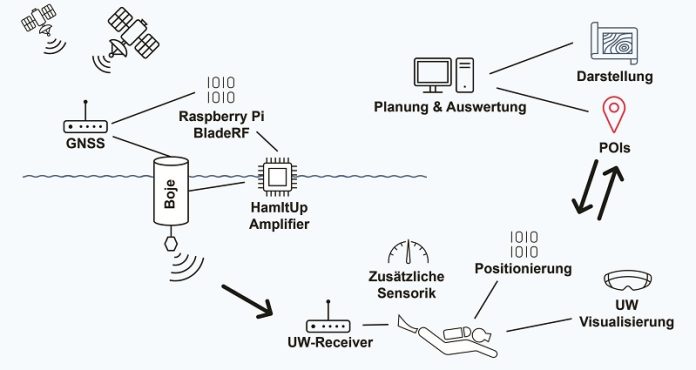
Engineers in Austria have developed a groundbreaking underwater navigation system that allows divers to find their way more easily and safely—without disturbing marine animals.
The new system uses floating buoys equipped with satellite technology and electromagnetic signals, offering a high-tech solution to a long-standing problem in underwater exploration.
Until now, divers have mostly relied on compasses or visual landmarks to navigate beneath the surface.
Some existing technologies use sonar-like systems that emit powerful sound waves, but these can stress or harm marine animals.
In contrast, the new system, developed during the FFG-funded ScubaPOIs project, offers a safer alternative that doesn’t disrupt the underwater environment.
Led by Philipp Berglez from the Institute of Geodesy at Graz University of Technology (TU Graz), the project combines satellite-based positioning with underwater signal transmission.
The system uses buoys that float on the water’s surface and determine their exact position using the Galileo High Accuracy Service (HAS), a precise satellite navigation tool.
These buoys then send out electromagnetic signals to divers below.
Divers carry small receivers, about the size of a snack-sized wafer packet, which pick up the signals from multiple buoys.
By calculating the distance to each buoy, the receiver can pinpoint the diver’s location and depth through a process called trilateration.
This information is then shown on a head-up display inside the diver’s mask, allowing them to navigate to underwater landmarks, avoid restricted zones, or return safely to their boat.
One of the biggest technical challenges the team faced was figuring out how electromagnetic signals travel through water.
Water properties like temperature, salinity, and conductivity can all change how signals move, making accurate distance calculations tricky.
Despite these challenges, the team successfully transmitted signals horizontally over a distance of 150 meters. While the system currently works best near the surface, researchers are optimistic that it can be improved for deeper dives of up to 100 meters.
The new navigation system opens up many exciting possibilities. In tourism, it could help recreational divers explore underwater sites more confidently. In science and conservation, it could aid work in aquatic ecology, underwater archaeology, and even tracking marine pollution.
Importantly, the system has been proven safe for marine life. Tests on golden rainbow trout—a fish known for being sensitive to environmental changes—showed no stress or abnormal behavior during or after exposure to the signals.
Observations taken immediately after the tests, as well as one week, one month, and four months later, all confirmed the fish remained healthy and unaffected.
This innovative system offers a big step forward in underwater navigation—helping humans explore the ocean more safely, while keeping the underwater world undisturbed.



